Complete Solutions to QUESTION BANK-15 of chapter METALS AND NON METALS of Class 8 book with complete answers and questions
| Class 8 | CHEMISTRY |
| Chapter | METALS AND NON METALS |
| S CHAND IIT JEE FOUNDATION | QUESTION BANK-15 |
| Number Of Questions | 100 |
| Academic Year | 2023-24 |
Name the constituents elements of solder along with composition ?
View SolutionThis is a list of metals in decreasing order of reactivity:
Sodium, calcium, magnesium, zinc, iron, lead, copper, gold.
Which metal is stored in kerosene oil?
View SolutionThis is a list of metals in decreasing order of reactivity:
Sodium, calcium, magnesium, zinc, iron, lead, copper, gold.
(i) Which metals react with cold water?
(ii) Which gas is given off in this reaction?
View SolutionThis is a list of metals in decreasing order of reactivity:
Sodium, calcium, magnesium, zinc, iron, lead, copper, gold.
(i) Name one metal that will not react with cold water but will react with steam.
(ii) Name two products of this reaction.
View SolutionThis is a list of metals in decreasing order of reactivity:
Sodium, calcium, magnesium, zinc, iron, lead, copper, gold.
(i) Name one metal that reacts slowly with dil. sulphuric acid.
(ii) Name two products of this reaction.
View SolutionThis is a list of metals in decreasing order of reactivity:
Sodium, calcium, magnesium, zinc, iron, lead, copper, gold.
Which of the metals will not react with oxygen when heated?
View SolutionThis is a list of metals in decreasing order of reactivity:
Sodium, calcium, magnesium, zinc, iron, lead, copper, gold.
Which metal forms an oxide when heated in air but does not react with acid?
View SolutionTabulate the differences between the chemical properties of metals and non-metals with respect to the following properties.
Reaction with oxygen, reaction with dil. acid, electrolysis
View SolutionCopy and complete the following table

View SolutionTwo materials A and B are heated separately in air. The product formed is dissolved in water. How will you identify which one is a metal?
View SolutionYou are given a piece of charcoal. How will you find out whether it forms basic oxide or acidic oxide.
View SolutionOne day Kavita went to a jewellers shop with her mother. Her mother gave an old metal jewellery to the goldsmith to polish. Next day when they brought the jewellery back, they found that there was a slight loss in its weight. Can you suggest a reason for the loss in weight?
View Solution(i) Describe the reaction by which iron gets rushed.
(ii) Does copper also get rusted? A greenish deposit is seen on the surface of copper vessels.
View SolutionWhat is added to steel to make it stainless steel?
View SolutionState two necessary conditions for rusting.
View SolutionState two ways by which rusting can be prevented.
View Solution(i) What is an alloy?
(ii) An alloy usually has some property which makes it particularly useful. What is the special property of (i) Duralumin (ii) Type metal
View SolutionWhat is the most important chemical process in the extraction of any metal? State how the essential step is carried out in the extraction of iron.
View SolutionNon-metals are poor conductors of electricity. Which allotrope of the non-metal carbon conducts electricity.
View SolutionHow many valence electrons are present in following elements ?
(i) sodium
(ii) aluminium
(iii) carbon
View SolutionHow many valence electrons are present in non-metals?
View SolutionWhich metals do not corrode casily?
View SolutionName two metals which will displace hydrogen from dilute acids, and two metals which will not displace hydrogen from dilute acids.
View SolutionWhich gas is produced when dilute hydrochloric acid is added to a reactive metal? Write the chemical reaction when iron reacts with dilute `H_2SO_4`.
View SolutionYou are given a hammer, a battery, a bulb, wires and a switch.
(a) How could you use them to distinguish between samples of metals and non-metals?
(b) Assess the usefulness of these tests in distinguishing between metals and non – metals.
View SolutionWhat do you mean by amphoteric oxides? Give examples along with reaction.
View SolutionWhy is copper used to make hot water tanks but steel (an alloy of iron) is not used?
View SolutionState two ways by which rusting can be prevented ?
View SolutionWhat type of oxides are formed when non-metals combine with oxygen?
View SolutionSameer took sulphur powder on a spatula and heated it. He collected the gas evolved by inverting a test tube over it as shown in the figure.
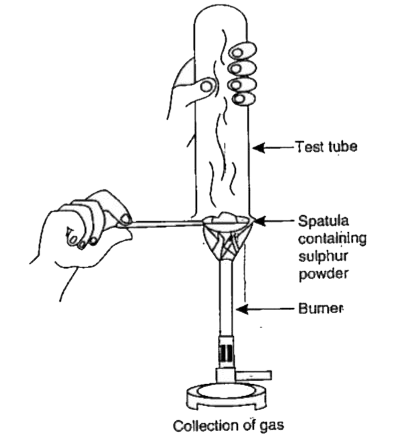
What will be the action of gas on dry litmus paper?
View SolutionSameer took sulphur powder on a spatula and heated it. He collected the gas evolved by inverting a test tube over it as shown in the figure.
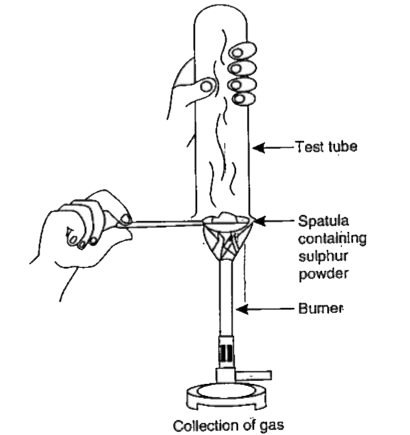
What will be the action of gas on moist litmus paper?
View SolutionSameer took sulphur powder on a spatula and heated it. He collected the gas evolved by inverting a test tube over it as shown in the figure.
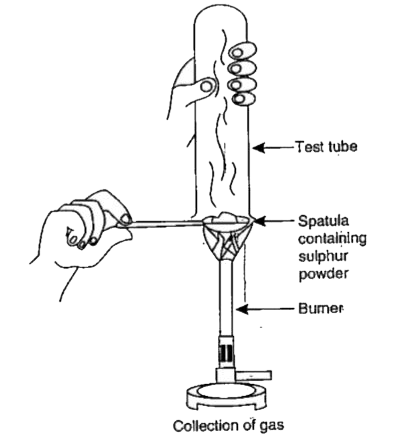
Write a balanced chemical equation for the reaction taking place.
View SolutionYou must have seen tarnished copper vessels being cleaned with lemon or tamarind juice. Explain why these sour substances are effective in cleaning the vessels.
View SolutionWhy does magnesium ribbon start floating in hot water?
View SolutionWhy do gallium and cesium melt in our palm?
View SolutionA metal with shining appearance reacts with hot water and also with dilute hydrochloric acid evolving hydrogen gas. Suggest giving reason why this metal cannot be copper.
View SolutionFrom the set of metals- zinc, iron, copper and silver, select the following giving equation for reaction.
Two metals which will liberate hydrogen from water.
View SolutionFrom among the set of metals-sodium, zinc, iron, copper and silver, select the following giving equation for reaction.
One metal which is used to prepare hydrogen gas in the laboratory.
View SolutionFrom among the set of metals-sodium, zinc, iron, copper and silver, select the following giving equation for reaction.
One metal which will displace copper from copper sulphate solution.
View SolutionFrom among the set of metals-sodium, zinc, iron, copper and silver, select the following giving equation for reaction.
One metal which will not displace copper from copper sulphate solutions.
View SolutionName one metal in following fitting the given description. Also, write the equation of the reaction.
A metal which floats on water, reacts with it and forms an alkali.
View SolutionName one metal in following fitting the given description. Also, write the equation of the reaction.
A metal that displaces silver from silver nitrate solution.
View SolutionName one metal in following fitting the given description. Also, write the equation of the reaction.
A metal which is used for galvanising iron.
View SolutionName one metal in following fitting the given description. Also, write the equation of the reaction.
A metal that reacts with oxygen without burning.
View SolutionName one metal in following fitting the given description. Also, write the equation of the reaction.
A metal that burns in oxygen with a bright light.
View SolutionZinc is extracted from zinc blende. The zinc blende is roasted. The solid product is mixed with coke in a blast furnace from which zinc vapours emerge.
What is the zinc compound in zinc blende?
View SolutionZinc is extracted from zinc blende. The zinc blende is roasted. The solid product is mixed with coke in a blast furnace from which zinc vapours emerge.
Write the equation for the roasting of zinc blende.
View SolutionZinc is extracted from zinc blende. The zinc blende is roasted. The solid product is mixed with coke in a blast furnace from which zinc vapours emerge.
What is the type of chemical reaction carried out after roasting in order to obtain zinc?
View SolutionZinc is extracted from zinc blende. The zinc blende is roasted. The solid product is mixed with coke in a blast furnace from which zinc vapours emerge.
What is the purpose of using coke?
View SolutionZinc is extracted from zinc blende. The zinc blende is roasted. The solid product is mixed with coke in a blast furnace from which zinc vapours emerge.
What is the reducing agent in the extraction?
View SolutionZinc is extracted from zinc blende. The zinc blende is roasted. The solid product is mixed with coke in a blast furnace from which zinc vapours emerge.
What is the name of the alloy formed by copper and zinc?
View SolutionFrom the metals copper, iron, magnesium, sodium and zinc, select from metal which does not react with dilute hydrochloric acid
View SolutionFrom the metals copper, iron, magnesium, sodium and zinc, select from metal which can form `2^(+)` and `3^(+)` ions
View SolutionFrom the metals copper, iron, magnesium, sodium and zinc, select from metal which has a oxide that reacts with both acids and alkalies
View SolutionFrom the metals copper, iron, magnesium, sodium and zinc, select from metal which does not react with cold water but reacts with steam when heated.
View SolutionFrom the metals copper, iron, magnesium, sodium and zinc, select from metal which arrange the metals in decreasing order of reactivity.
View SolutionX is an element in the form of a powder. X burns in oxygen and the product is soluble in water. The solution is tested with litmus. Write down only the word, which will correctly complete the following sentence.
If X is a metal, then the litmus will turn ____
View SolutionX is an element in the form of a powder. X burns in oxygen and the product is soluble in water. The solution is tested with litmus. Write down only the word, which will correctly complete the following sentence.
If X is a non-metal, then the litmus will turn ____
View SolutionX is an element in the form of a powder. X burns in oxygen and the product is soluble in water. The solution is tested with litmus. Write down only the word, which will correctly complete the following sentence.
If X is a reactive metal, then ____ will be evolved, when X reacts with dilute sulphuric acid.
View SolutionX is an element in the form of a powder. X burns in oxygen and the product is soluble in water. The solution is tested with litmus. Write down only the word, which will correctly complete the following sentence.
If X is a metal it will form ____ oxide, which will form ____ solution with water.
View SolutionX is an element in the form of a powder. X burns in oxygen and the product is soluble in water. The solution is tested with litmus. Write down only the word, which will correctly complete the following sentence.
If X is a non-metal it will not conduct electricity unless it is carbon in the form of ____
View SolutionList 1 contains `"metals"//"alloys"` 1, 2, 3, 4, 5 and list 2 contains their uses A, B, C, D, E.
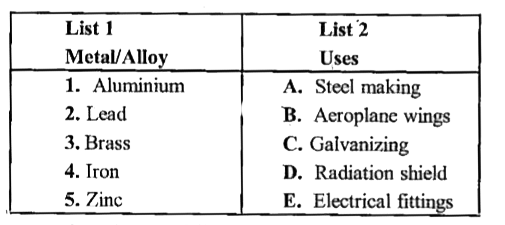
Complete the following table, matching the metals with their correct uses.

View SolutionA to F below relate to the source and extraction of either Zinc or Aluminium.
A. Bauxite`" "`B. Coke
C. Cryolite`" "`D. Froth floatation
E. Sodium hydroxide solution F. Zine blende
Write down the three letters each from the above list which are relevant to Zinc
View SolutionA to F below relate to the source and extraction of either Zinc or Aluminium.
A. Bauxite`" "`B. Coke
C. Cryolite`" "`D. Froth floatation
E. Sodium hydroxide solution F. Zine blende
Write down the three letters each from the above list which are relevant to Aluminium
View SolutionA to F below relate to the source and extraction of either Zinc or Aluminium.
A. Bauxite`" "`B. Coke
C. Cryolite`" "`D. Froth floatation
E. Sodium hydroxide solution F. Zine blende
Fill in the blanks using the most appropriate words from A to F.
The ore from which aluminium is extracted must first be treated with _____ so that pure aluminium oxide can be obtained.
View SolutionA to F below relate to the source and extraction of either Zinc or Aluminium.
A. Bauxite`" "`B. Coke
C. Cryolite`" "`D. Froth floatation
E. Sodium hydroxide solution F. Zine blende
Fill in the blanks using the most appropriate words from A to F.
Pure aluminium oxide is dissolved in ____ to make a conducting solution.
View SolutionA to F below relate to the source and extraction of either Zinc or Aluminium.
A. Bauxite`" "`B. Coke
C. Cryolite`" "`D. Froth floatation
E. Sodium hydroxide solution F. Zine blende
Write the formula for cryolite
View SolutionFrom the list of characteristics given below, select the five which are relevant to non-metals and their compounds.
Write the letters corresponding to the correct characteristics.
A. Ductile
B. Conduct electricity
C. Brittle
D. Acidic oxides
E. Basic oxides
F. Discharged at anode
G. Discharged at cathode
H. Ionic chlorides
I. Covalent chlorides
J. Reaction with dilute sulphuric acid yields hydrogen.
K. 1, 2 or 3 valence electrons
L. 5, 6 or 7 valence electrons
View SolutionThe diagram shows the sketch of an electrolytic cell used in the extraction of aluminium.
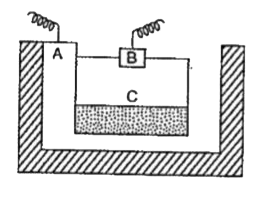
What is the substance of which the electrodes A and B are made?
View SolutionThe diagram shows the sketch of an electrolytic cell used in the extraction of aluminium.

At which electrode (A or B) is the aluminium formed?
View SolutionThe diagram shows the sketch of an electrolytic cell used in the extraction of aluminium.

What are the two aluminium compounds in the electrolyte C?
View SolutionThe diagram shows the sketch of an electrolytic cell used in the extraction of aluminium.
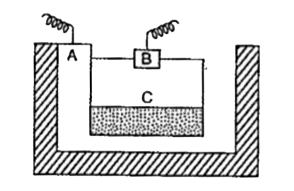
Why is it necessary for electrode 'B' to be continuously replaced?
View SolutionIn the electrolytic refining of a metal M, what would you take as the anode, the cathode and the electrolyte?
View SolutionOn placing a piece of zinc metal in a solution of mercuric chloride, it acquires a shining silvery surface but when it is placed in a solution of magnesium sulphate, no change is observed. Explain.
View SolutionName two metals that do not corroide easily. Give an example in support of each of the following statements.
(i) Corrosion of metals is an advantage
(ii) Corrosion of a metal is a serious problem
View SolutionFood cans are coated with tin and not with zinc because
View SolutionFour students A, B, C, and D took aqueous solutions of zinc sulphate and iron sulphate in two test tubes I and II and dropped metal pieces of Iron and Zinc in the two solutions. After several hours, they made observations and recorded their findings in the form of a table given below:
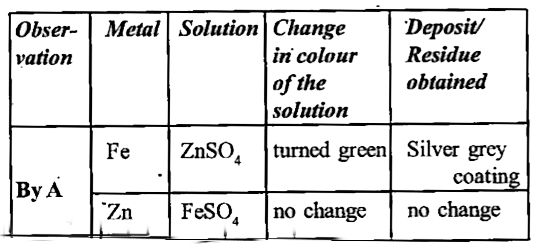

Who reported the correct observation?
View SolutionWhich of the following pairs will give displacement reactions?
View SolutionWhich of the following methods is suitable for preventing an iron frying pan from rusting?
View SolutionAn element reacts with oxygen to give a compound with a high melting point. This compound is also soluble in water. The element is likely to be:
View SolutionA piece of granulated zinc was dropped into copper sulphate solution. After some time, the colour of the solution changed from:
View SolutionGive reason:
Metals like palladium, silver and gold are used to make jewellery
View SolutionGive reason:
Sodium, potassium and lithium are stored under oil
View SolutionGive reason:
Aluminium is a highly reactive metal, yet it is used to make utensils for cooking
View Solutiongive reason for the following:
Carbonate and sulphide ores are usually converted into oxides during the process of extraction of metals.
View SolutionGive reason:
Metals are regarded as electropositive elements
View SolutionGive reason:
Carbon is not used for making aluminium from aluminium oxide
View SolutionGive reason:
Metals conduct electricity
View SolutionMetallic oxides of zinc, magnesium and copper were heated with the following metals.

In which cases will you find displacement reactions taking place?
View SolutionA student has been collecting silver coins and copper coins. One day she observed a black coating on silver coins and a green coating on copper coins. Which chemical phenomenon is responsible for these coatings ? Write the chemical names of black and green coatings ?
View SolutionA metal 'M' has the electronic configuration is 2, 8, 3 - and occurs in nature as `M_2O_3 2H_2O`. It is more reactive than Zinc. Answer the following question:
Name the metal 'M'
View SolutionRusting of iron involves
View SolutionWhich of the following metals can displace hydro-gen from dilute acids?
View SolutionThe ore of which of the following metals can be concentrated by hydraulic washing?
View SolutionWhich of the following alloys is used for making magnets?
View SolutionMatch the following:
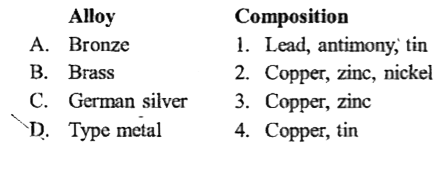
View SolutionWhich of the following metals was first discovered by man?
View SolutionWhen an iron nail gets rusted, iron oxide is formed
View SolutionOf the following metals which one pollutes the air of a big city?
View SolutionWhich of the following is an incorrect statement?
View Solution
QUESTION BANK-15 questions and complete solutions for chapter METALS AND NON METALS of S CHAND IIT JEE FOUNDATION of Class 8